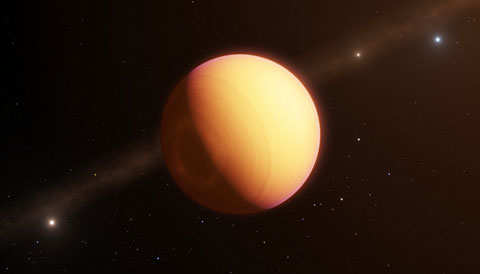Astronomers have taken the best spectrum yet of exoplanet HR 8799e, a gas giant in its infancy.
Among the almost 4,000 exoplanets confirmed to date, the vast majority have been detected indirectly, by looking for the effect of the planets on their host stars. Only about 45 confirmed planets have been imaged directly, most of them young gas giants still glowing with the warmth of their birth. Among the most famous of these is the system HR 8799, in which four gas giant planets orbit a young, 30 million-year-old star 130 light-years away.
Now, using the Gravity instrument at the European Southern Observatory's Paranal Observatory in Chile, Sylvestre Lacour (Observatory of Paris and Max Planck Institute for Extraterrestrial Physics, Germany) and colleagues have followed the orbit of the innermost planet, HR 8799e, and measured its spectrum in unprecedented detail. The results appear March 27th in Astronomy & Astrophysics.

ESO / L. Calçada
The Gravity instrument combines the light collected by the Very Large Telescope's four 8.2-meter telescopes, which work together as a single much larger telescope via a technique known as interferometry. As a result, the team could better separate the planet's light from its star's, enabling them to pinpoint its position and orbit. The planet's path appears to be slightly inclined (by 25°) compared to the other planets' orbits.
The better separation of the planet's light also enabled the team to take an unprecedentedly detailed spectrum of the planet's atmosphere, revealing an abundance of carbon monoxide where they had expected methane. “We can best explain this surprising result with high vertical winds within the atmosphere preventing the carbon monoxide from reacting with hydrogen to form methane,” says Lacour in a press release.
In addition, clouds of iron and silicates are necessary to understand the spectrum the team observes. “Our observations suggest a ball of gas illuminated from the interior, with rays of warm light swirling through stormy patches of dark clouds,” Lacour explains. “Convection moves around the clouds of silicate and iron particles, which disaggregate and rain down into the interior.
Lacour and colleagues find that most of the imaged planets known today are within Gravity's reach, so we can expect more details on other young giants' atmospheres before long.
 1
1
Comments
Dobsonite
March 29, 2019 at 6:29 pm
"...a ball of gas illuminated from the interior,..."
.",,,clouds of silicate and iron particles, which disaggregate and rain down into the interior."
When I was a kid (late Cenzoic) there were arguments about whether or not there _were_ planets around other suns.
Iron rain in carbon monoxide? This is truly mind boggling.
Science needs a new motto: "If you don't like this week's/year's/decade's theories, check back later."
Which is as it should be.
The final mystery is unknowable; it's all about the journey...
You must be logged in to post a comment.
You must be logged in to post a comment.